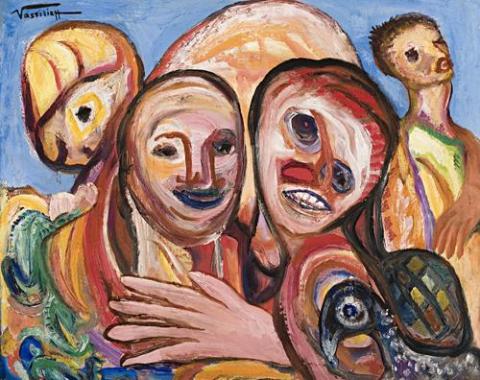SWAN HILL, c.1955
Danila Vassilieff
oil on canvas
49.0 x 63.0 cm
inscribed upper left: Vassilieff
The Reed Family Collection, Victoria
Forgotten Treasures, Heide Museum of Modern Art, Melbourne, 1994
Moments of Mind: The Sweeney Reed Collection, Heide Museum of Modern Art, Melbourne, 25 January – 6 July 2003
Following the separation from his second wife Elizabeth Hamill and departure from their 'Stonygrad' house, Vassilieff moved to Mildura where, on 3 May 1954, he was appointed as a temporary assistant teacher at Mildura High School. Although his direct personality, boyish humour and love of companionship won him friends within the academic and broader local community, Vassilieff nevertheless remained an 'outsider'. Such unhappiness was exacerbated moreover by the teaching difficulties he encountered adjusting from a small progressive school to a departmental one where classes of around forty students'of the non-academic, relegated-to-art variety, were not uncommon.' As Felicity St John Moore notes, 'his discipline was a fiasco: he just stood up in front of the class and, in his heavily accented voice, expressed himself, waving his arms to demonstrate his meaning while pupils jumped out of windows or hung from the rafters... The children, considering eccentric his devotion to art and lack of pretension, and assuming he was 'red', nicknamed him 'Professor Petrov...'1
Not surprisingly perhaps, after a year Vassilieff was transferred in April 1955 to Swan Hill High School - the standard procedure for poor disciplinarians - where sadly he found himself even less settled than in Mildura due to the relative isolation of the area, colder weather which affected his health and equally parochial attitudes towards his art. Fortunately however, the headmaster (also one of the artist's fishing companions) was extremely sympathetic to him, and indeed, upon his departure in 1956 remarked that, unlike most of the staff, 'Dan was able to give the children a sense of achievement and confidence.'2
One of a group of figure studies depicting members of the local community which Vassilieff undertook during his time in Mildura and Swan Hill, the present work poignantly reflects the artist's transition from the sophisticated, intellectual milieu of Warrandyte to a relatively commonplace world of day-to-day human contact. Contrasting starkly with his emotionally objective portraits of the thirties and forties, such works may be considered both 'assertions of his presence and gestures of communication'3 - their psychological resonance, rounded expressive forms and swirling scooped lines bearing strong affinities with the art of Norwegian expressionist Edvard Munch. Moreover, with the faces of his protagonists here violently and ludicrously distorted, Swan Hill, c.1955, not only recalls the haptic tendencies of children's art, but alludes to the more aggressive and satirical direction Vassilieff's art would follow as he retaliated against the blindness and stupidity which he perceived in a society insensible to his vision.
1. St John Moore, F., Vassilieff and his art, Oxford University Press, Melbourne, 1982, cat. s72, p. 95 (illus.)
2. ibid., p. 121
3. ibid., p. 115
VERONICA ANGELATOS
